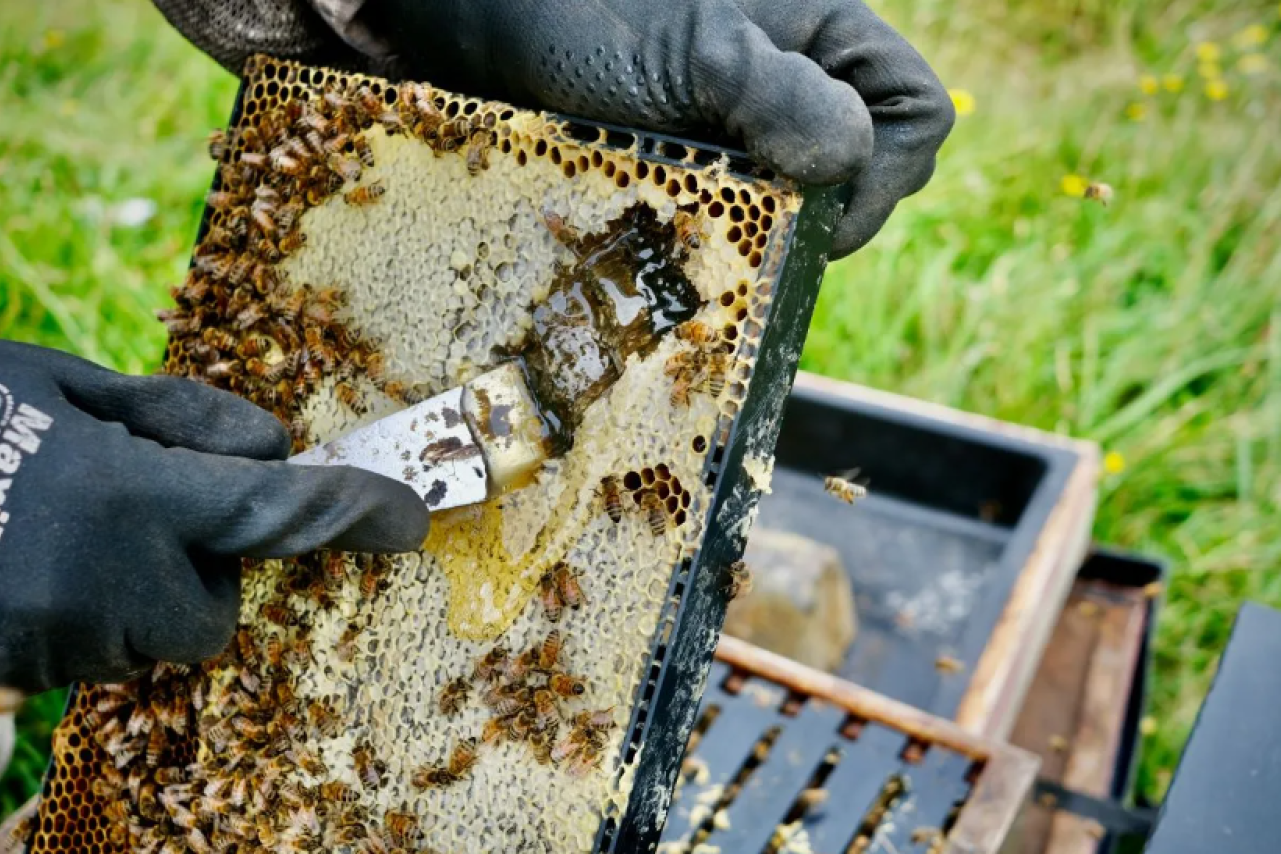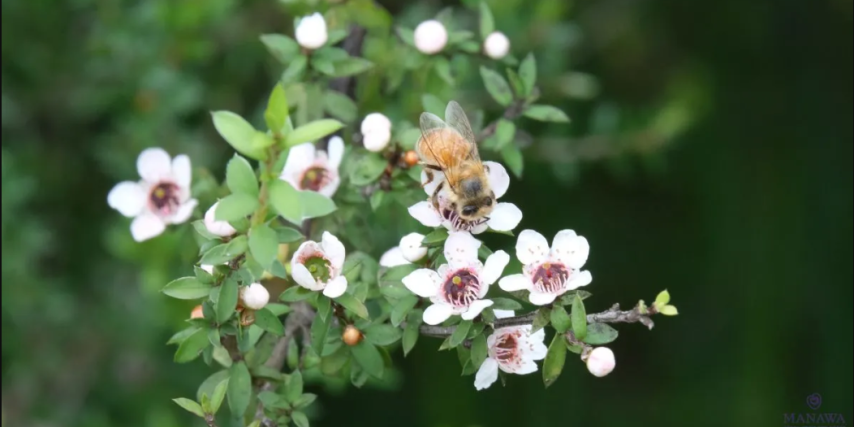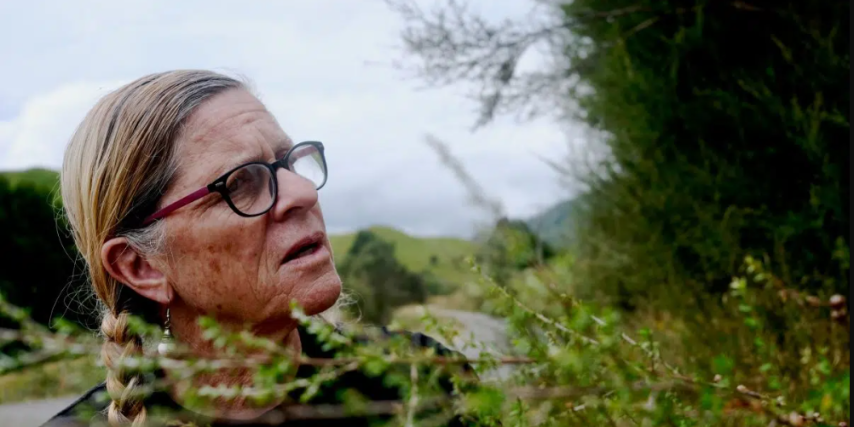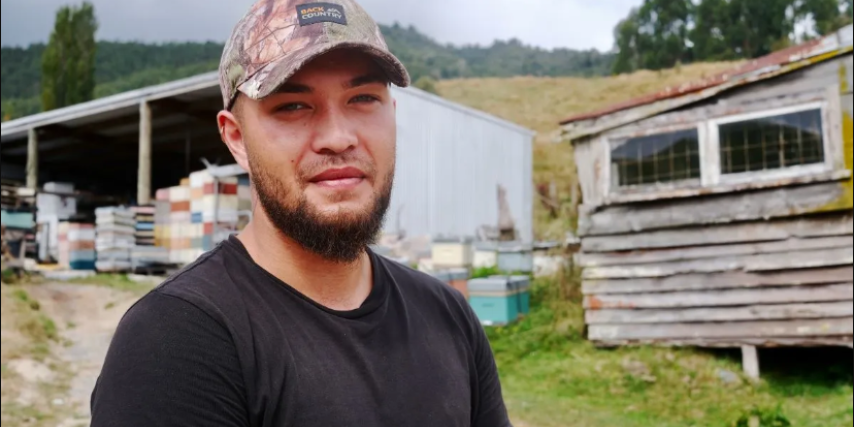
Mānuka Honey was once 'rubbish honey'!
“Mānuka honey was scorned for a long time – now it is considered a globally sought- after superfood. How did that happen? A search for clues in the New Zealand rainforest.”
Manawa Honey NZ - Māori Producer of Mānuka Honey
The bees can even be heard in the pick-up truck. More of a menacing buzzing than buzzing. Brandyn Koroa is sitting behind the wheel. The windows have already been closed by him at the gate to the meadow for safety reasons. Now he pulls up the zipper of his protective suit and folds the head protection forward. “Most of the bees are nice though, I rarely get stung,” he says. It helps not to be afraid. “If I’m calm, then the bees are too. They notice everything.”
Koroa gets out. Extremely calm. In total 18 colonies live in the hives in front of him. With luck, each of them will produce 100 kilos of honey per week. They stand there in pink, green and yellow wooden boxes. They reach right up to the the edge of the forest, whose dense greenery looks as if it reaches up to the sky.
In his white beekeeper’s suit Brandyn Koroa looks against the mountain backdrop of the Te Urewera rainforest, the largest and most remote on New Zealand’s North Island, as if he has just stepped onto another planet.
Koroa has only been working as a beekeeper for a few months. He is actually an electrician, but the 25-year-old has returned back home for his new job. He previously lived in the city of Rotorua, a long drive away over partly-gravel windy roads. In Ruatāhuna, a Māori community of 400 people, there are not many opportunities to earn money. One grocery store, a petrol station, lots of free-roaming horses. And a lot of forest. Koroa has now built a house in this place.
This is possible because some of the bees that Brandyn Koroa looks after produce a special honey. Honey that is known worldwide and sells well: Mānuka. It is a type of honey made from the flower nectar of the tree species Leptospermum scoparium growing in New Zealand and parts of Australia, also known as South Sea myrtle or Mānuka, a word from the Māori language.
The honey contains methylglyoxal (MGO), a unique bioactive component that provides it with a strong antibacterial effect. Highly concentrated and purified, it is used by some hospitals to heal wounds. The actress Scarlett Johansson smears it on her face to treat pimples. Kourtney Kardashian, the oldest sister in the clan, eats Mānuka by the spoonful for her general health.
As a child, Brandyn Koroa lit Mānuka bushes with his Grandpa. The branches burn well. In the fire, they smoked the meat of the deer they had hunted in the forest. Some neighbors used Mānuka bark and leaves to treat colds or skin diseases. Honey came much later.

Brandyn Koroa, beekeeper of Manawa Honey NZ. (Photo Credit: Anne Backhaus)

Honey bee on the flower of the Mānuka tree. Bees don't prefer this nectar but they will harvest it for making Mānuka Honey. (Photo Credit: Canva)
Mānuka Honey - from ‘Rubbish’ to Superfood
Koroa’s boss, the manager of Mānawa Honey, remembers that in the early 2000s years, nobody wanted Mānuka Honey. “Really nobody. It was rubbish honey,” says 68-year-old Brenda Tahi. She slaps her flat hand on the conference table where she eats lunch with her team and packs the Mānuka Honey parcels, which now go to all corners of the world. Next to her are a few of the amber jars into which they fill the honey and offer it for sale. It has to be stored away from light, so as not to lose its special properties.
Mānuka Honey has an intense flavour and is not as sweet as other varieties. The main reason for the rejection of Mānuka, however, was another, says Tahi: “Mānuka Honey is dark. People didn’t like that. Only white honey was considered pure. Like with skin colors, complete nonsense.” Then she laughs, although she doesn’t actually find it funny.
Because it wasn’t just about the honey, but also about “our dark people”.
New Zealand was the last country in the world to be discovered and colonized. The first people from Polynesia arrived a good 300 years before the European seafarers with their waka, the traditional canoes. They stayed, built settlements. In 1642, the Dutch explorer Abel Tasman arrived, later followed by the British, who brought the first honeybees with them. In 1840, the colonial power concluded the Treaty of Waitangi with the Māori chiefs. It is regarded as the founding document of the country and introduced British legislation. At the same time, it gave the Māori authority over their land and culture.
This was not honored. More and more British settlers arrived in the middle of the 19th century, killed, raped and took from the Māori a large part of their land. They were allowed to keep areas that were considered worthless. “For example, the areas where Mānuka grows,” says Brenda Tahi – and points outside. Here on the North Island, framed by the Southwest Pacific and characterized by a subtropical climate, the Mānuka bushes thrive, often growing as tall as a tree. They look unspectacular, with spiky leaves on their branches, and they only bear flowers a few weeks a year. The bushes sprout like weeds from poor soil. “Remote mountain slopes where nobody can grow anything? Full of them!”
That’s why Tahi laughs as well: The supposedly useless land with the unattractive Mānuka bushes on it – it was underestimated by the colonial rulers but now has immense value.

Brenda Tahi, CEO of Manawa Honey NZ explaining the Mānuka Tree and the phenomenon of Mānuka Honey. (Photo Credit: Anne Backhaus)

Mānuka Honey broken open on a frame in the hives of Manawa Honey NZ (Photo Credit: Anne Backhaus)
The Phenomenon of Mānuka Honey
Within just a few years, Mānuka Honey has risen from an unpopular fringe product to a superfood and has become a super export. And super expensive.
In German organic stores, 250 grams of honey can easily cost 85 euros. The price depends on the MGO content of the honey: the higher it is, the more expensive the honey. A low MGO value is 30 milligrams per kilo, a high one is 850 or 1,200. At the airport in Auckland 230 grams of honey with an MGO value of 2,050 sells for the equivalent of 1,200 euros – at least free of duty and taxes.
The higher the value, the more intense the taste. “I wouldn’t put that on my toast,” says Megan Grainger, who was instrumental in the discovery of methylglyoxal. “Many people think: the more expensive the honey, the better. But normal consumers don’t need the high MGO concentrations.”
The Benefits of Mānuka Honey
Grainger, 36, is an analytical chemist, her office on the third floor of the University of Waikato is just a few doors away from the laboratory where, as a student in 2006, she isolated and identified methylglyoxal in Mānuka Honey. A sugar degradation product from the Mānuka flower nectar that only forms in the sealed honeycombs in the beehive. “At the time, we didn’t realize what this discovery would ultimately mean. It was rather one piece of the puzzle of many to better understand how Mānuka works.”
The university in Hamilton, roughly halfway between the airport in Auckland and the bees in the rainforest, is considered the cradle of Mānuka research. Grainger was part of a team led by Peter Molan, who had been studying honey since the 1980s and laid the foundations for a multimillion-dollar industry. “The gold rush”, as many here call it. Molan also came up with the name UMF, which stands for Unique Mānuka Factor. As a quality feature, it can still be found on packaging. For a long time, UMF was the only classification system for Mānuka Honey. Just like MGO, it is still regarded as a seal of quality and authenticity of the honey.
With the discovery of MGO as an antibacterial ingredient began a scientific race that is still ongoing. Mānuka Honey is now regarded as the best-researched honey in the world – and the main aim is to find out what health problems this honey can counteract.
It was already known in ancient Egypt that honey cleans wounds. It was considered the “food of the of the gods”. Today it is drunk in tea for colds, sucked in cough drops.
Mānuka Honey from New Zealand is used by people in the USA, China and Europe because they consider it to be particularly healing. There are many reasons to believe this. However, while the external effect is scientifically well documented, there are no clear results yet as to which extent the honey you eat has a healing power inside the body.
Companies like Comvita, which is considered the world market leader in the production of Mānuka Honey, spend millions on clinical studies with which they want to prove, for example, that Mānuka can also work against diseases of the digestive system. In March, Comvita presented the first partial results of a new study at a conference in Wellington.
Companies are not allowed to advertise the benefits of honey for human health. Neither in the European Union nor in New Zealand.
Nevertheless, the salespeople in the Comvita store in the port of Auckland, the country’s largest city, also tell visitors, without being asked, how good the Mānuka Honey is for the stomach and digestion. The “Comvita Wellness Lab” with its “hive room” is also located here, where thousands of tourists arrive on cruise ships every day.
Honey tasting becomes a multi-sensory experience when bees are on a 180-degree screen sucking on flowers – and their eager buzzing can be heard throughout the room. There are tasting jars of different types of honey at the table. And as soon as the first drop is on the tongue, chunks of licorice, burnt toast, chocolate and cinnamon fly towards the taster from the screen to spherical sounds. And all of this can actually be tasted in Mānuka Honey. The preconception that it’s not tasty at all – done.


Brandyn Koroa, beekeeper of Manawa Honey NZ, now able to live back in his ancestral home, Ruatāhuna. (Photo Credit: Anne Backhaus)

